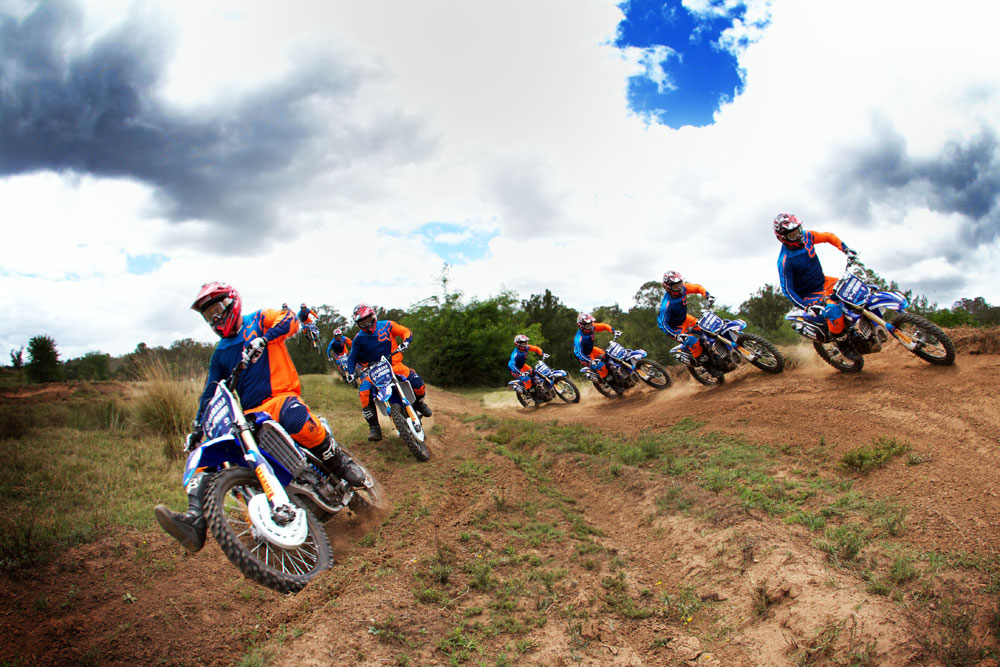
When you have a jump followed closely by a corner it can make two relatively easy obstacles much more technical
STORY SHANE BOOTH | PHOTOGRAPHY MATT BERNARD
It’s easy to rush your entry into a corner at the best of times, so when you add a jump that has you landing only a few metres from a turn it really does increase the difficulty of that section. You need to be accurate with your jumping distance: too short and you will bounce off the down ramp and into the corner; too long and you may overshoot the turn. Neither case is ideal — you really need to land the jump perfectly to get the bike settled as quickly as possible so you can set up for your corner entry.
PICK YOUR LINE
Decide nice and early which line you want to use in the turn. You need to set yourself up before the jump so that you’re landing on the line you’ve chosen for the turn; it’s too late to change your mind once you’re in the air. In this case the berm is the easier option: it doesn’t require you to wash off as much speed, which makes it a little less technical, but it is the longer way around the corner. The inside line is tougher to get into but shortens up the turn and would also work well as a passing option.
LOOK AHEAD
Keeping your eyes up and looking ahead will make a big difference in this scenario. As soon as you’re in the air, spot your landing. Once you’re happy that you’ll be landing in the right position, look up into the turn at the line you want to use. The further ahead you can keep your vision the more time you give yourself to process what’s going on, which will help. It’s easy on a section like this to get in a panic when you land and everything happens in a bit of a blur. Where you look will help prevent that happening.
BRAKING
When you’re landing into a turn, ideally you want to land slightly front wheel first. This allows you to start applying a slight amount of front brake immediately; it also lets you begin to steer the bike to where you want it to go. How you use your brakes is important here: if you’re heading to the inside you need to wash a chunk of speed off quickly but if you’re too aggressive on the front brake you can easily tuck the front end and crash. Only increase your front brake use once the front wheel is settled and has some load on it, which will give it the traction needed to brake. If you’re going to the berm, you still need to wash off some speed but you’ll be doing it mostly in a straight line rather than trying to turn in like you are on the inside. This makes the brake application a little easier and there’s less risk of a crash from losing the front end. Remember that you only need to wash some speed off — you don’t need to come to a standstill. So once you’ve slowed your speed, release the brakes and flow through the turn.
BODY POSITION
Stay in the standing position for the landing and for your braking — you’ll be able to brake harder and maintain more control of the bike this way. You don’t want to sit down until the bike is totally settled and you’re at the speed you want for the turn. It’s common to see riders panic, drop to the seat as they land, stop on the rear brake and overshoot the turn. Avoid this: stay standing, get the bike slowed and settled then sit for the turn.
MISTAKES
Most mistakes will happen here when you attempt to use the inside line; any error in the judgement of your jumping distance will need a quick-thinking reaction. If you’re going for the inside and either of these happen, remember you have the berm that you can go to on the outside of the corner. You are much better off deciding quickly to abort the inside line and run wide to the berm, even if it means you only catch the end of it. This gives you more time to get the bike under control and saves the chance of crashing while trying to salvage the inside line from a mistake.

